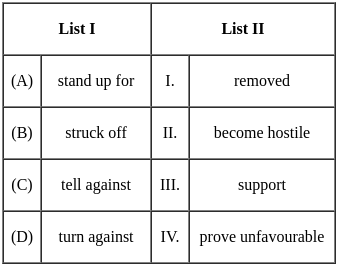English Language Mock Test - 4 - CUET MCQ
30 Questions MCQ Test CUET UG Mock Test Series 2026 - English Language Mock Test - 4
Convert the following sentence into its Exclamatory form:
"I wish that I were young again."
What is the meaning of the phrase ‘Feather in one's cap’.
Fill in the blank with the correct Preposition:-
The gift was so beautiful that he was overwhelmed ______ joy.
Match the words in List I with their meanings in List II

Choose the correct answer from the options given below:
Choose the correct Passive form of the sentence:
"This book will change your life".
Identify the indirect speech that expresses the following sentence:
Sara says, "I can sing very well."
Select the option that expresses the given sentence in future continuous tense.
A. They will meet at 3 PM tomorrow.
B. They are meeting at 3 PM tomorrow.
C. They meet at 3 PM tomorrow.
D. They will be meeting at 3 PM tomorrow.
Fill up the blank with the correct option.
Nobody __________ the fact.
Select the option that can be used as a one-word substitute for the given group of words.
Weakness and poor health
Choose the word that can substitute the given group of words.
One who hates institution of marriage
Select the word OPPOSITE in meaning to the underlined word.
The story was incredible.
Fill in the blank with the correct option.
She ____ to school every day.
Identify the part of speech of the underlined word.
The happy child played all day.
What is one primary advantage of technology in education?
What challenge related to technology in education is mentioned in the passage?
How does technology promote collaborative learning?
Which skill does technology help develop according to the passage?
What is one of the possible disadvantages of using technology in education?
What is the key conclusion about the role of technology in education?
What is the primary cause of rising global temperatures according to the passage?
Which of the following is an observable effect of climate change mentioned in the passage?
How does climate change affect agricultural productivity?
What human health risk is linked to rising temperatures, as per the passage?
What is identified as a major cause of respiratory diseases in the passage?
What is the recommended approach to addressing climate change?
What are human rights described as in the passage?
Where can the origins of human rights be traced back to?
Who were some of the philosophers that shaped the modern concept of human rights?
What major event led to the adoption of the Universal Declaration of Human Rights (UDHR)?
|
39 docs|145 tests
|



















